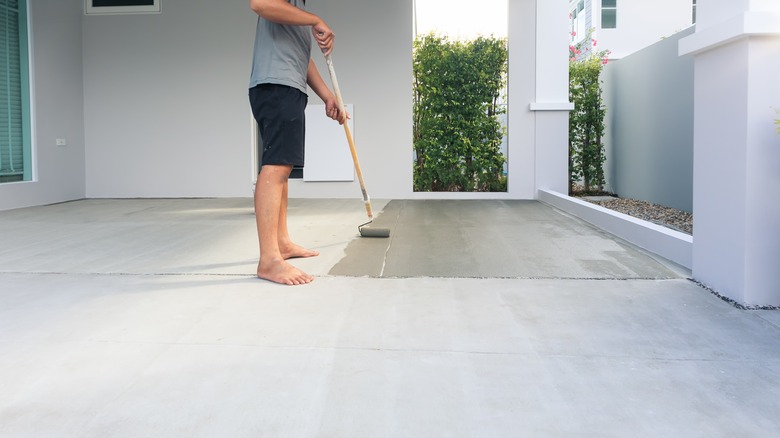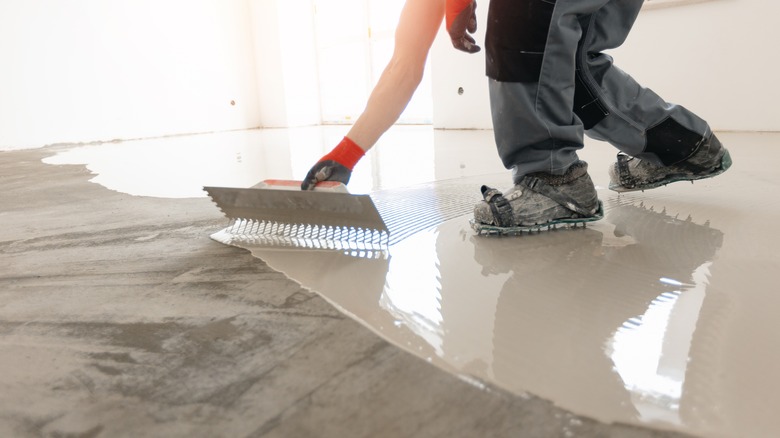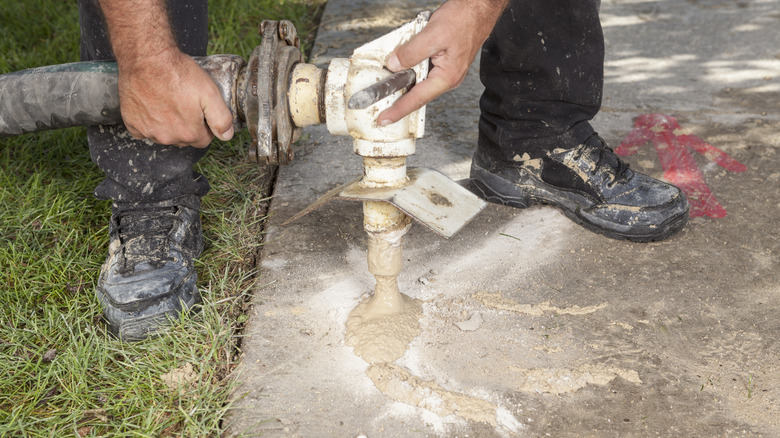The Popular Floor-Leveling Solution You Should Think Twice Before Using
Are you researching ways to fix an unlevel concrete floor? Whether the slab is uneven due to an installation error, or it's sunk or cracked, one of the most popular go-to ways to resurface — and relevel — it is with a self-leveling concrete compound. Self-leveling concrete is a liquid comprising cement and liquid polymer (or in some cases, water). You pour the mix onto the floor that needs repairs, and the liquid eventually settles in all its crevices and sunken spots. Once the compound cures, you're left with a perfectly smooth, level, and durable new surface. All this for just $6 per square foot, and with a seemingly straightforward process that any DIY would be tempted to tackle. Sounds too good to be true, doesn't it?
Despite its affordability, perceived simplicity of installation, and much-touted performance, self-leveling concrete is not ideal for every project. That's because this resurfacing method has several significant flaws, which include possible cracking and a lack of adherence to the slab beneath. Crucially, the application method may appear rudimentary, but an inexperienced DIYer can easily mess it up. Below, we'll walk you through the key challenges with using self-leveling concrete — this way, you can make an educated decision whether this resurfacing method is right for you.
The critical problems with using self-leveling concrete
The first issue with self-leveling concrete is that it may crack with time, as with any type of concrete. Since this concrete type has a fast curing time of less than a day, the cracks often emerge soon after the pour. And if you haven't repaired existing cracks in the slab below before application, they will continue to deteriorate and eventually stretch the new concrete layer to the point of breaking.
Another problem is that the application process requires more labor than you'd think — and more so than some unscrupulous contractors will tell you. Preparing the damaged surface is one hurdle. Before you pour the compound, you must clear, prime, and grind the surface, and repair concrete cracks, otherwise the mix may not adhere to the slab below. Also, you have little room to err with the mix preparation. A simple DIY concrete mistake of getting the ingredient ratios wrong can prevent the liquid from self-leveling or affect its ability to cure. Finally, you'll have to pick a day with the right temperature and humidity conditions for your pour, as specified by the manufacturer, and the timeframe within which you can get the job done is often less than half an hour.
One final problem with using a self-leveling compound is its limited utility. You can't use it to repair outdoor surfaces, even a basic concrete patio — the temperature swings will make quick work of the new layer and cause it to crack. Likewise, self-leveling concrete does not offer a long-term solution to major cracking or sinking issues, which will persist even after your resurfacing project.
Alternatives to using self-leveling concrete
When you're trying to repair an uneven slab, your alternatives to self-leveling concrete include raising the slab, grinding it down to a level surface, or replacing it altogether. Raising a slab involves drilling small holes into the parts of the concrete that have sunk, then filling the cavity with a special compound. This liquid exerts a pressure beneath the slab, and raises it back to the intended level. Eventually, this liquid cures and provides a solid substrate for the concrete.
Grinding the slab is another alternative. With this method, you'd use a grinder to remove portions of the concrete that are protruding above the surface to make the entire slab even. This method is inexpensive, generally costing only $2 per square foot. That said, the grinding process ruins the concrete's aesthetic by exposing its core.
The final alternative is to replace the slab altogether. This is a labor-intensive procedure, which entails demolishing the old slab, hauling away the debris, compacting and leveling the substrate, installing reinforcement, then pouring the concrete. You'll have to wait about a month after the new slab is poured before you can use the new concrete surface. Of all the alternatives to self-leveling concrete, slab replacement is the priciest. Old concrete removal costs about $3,000 on average, and new slabs can set you back as much as $5,500.


